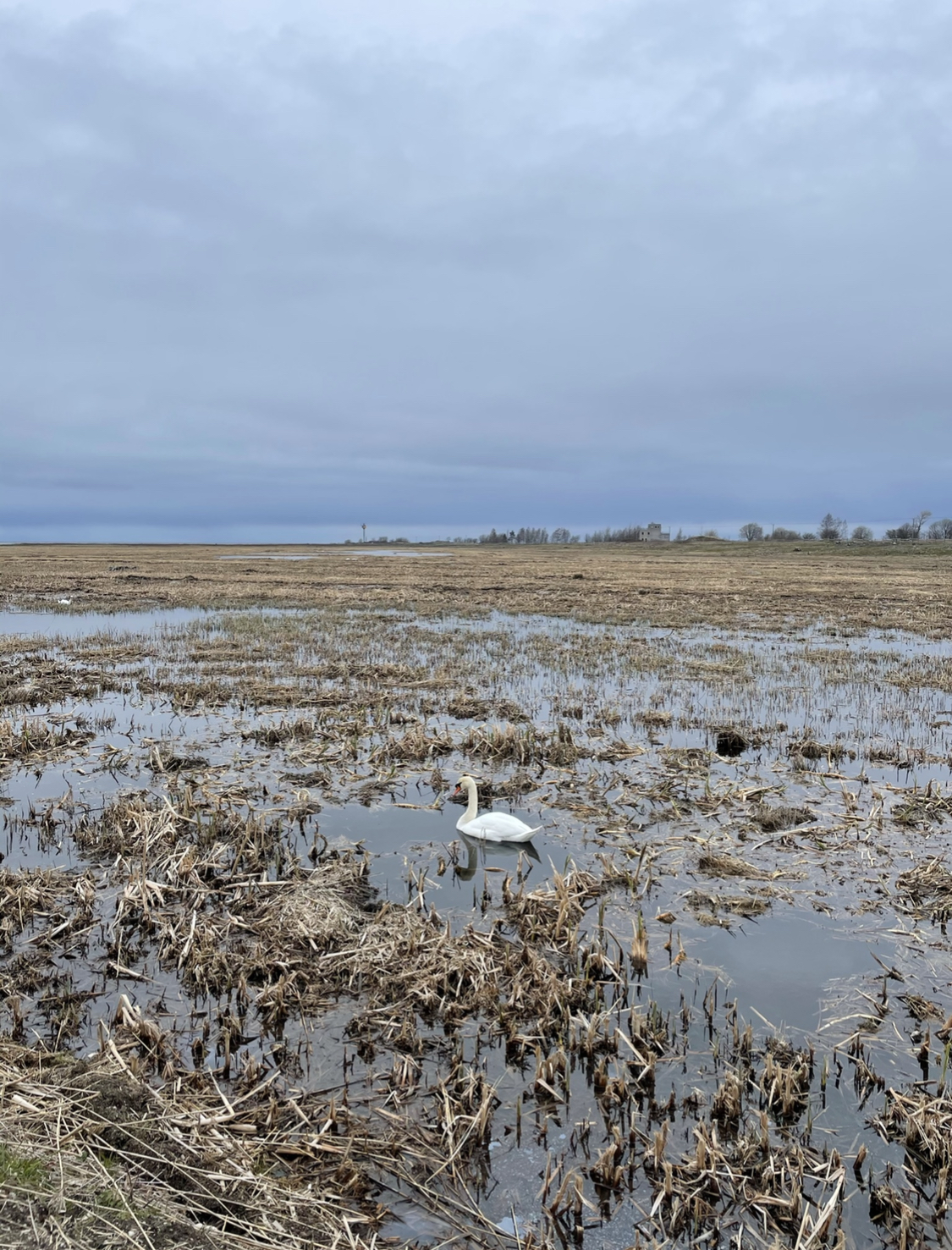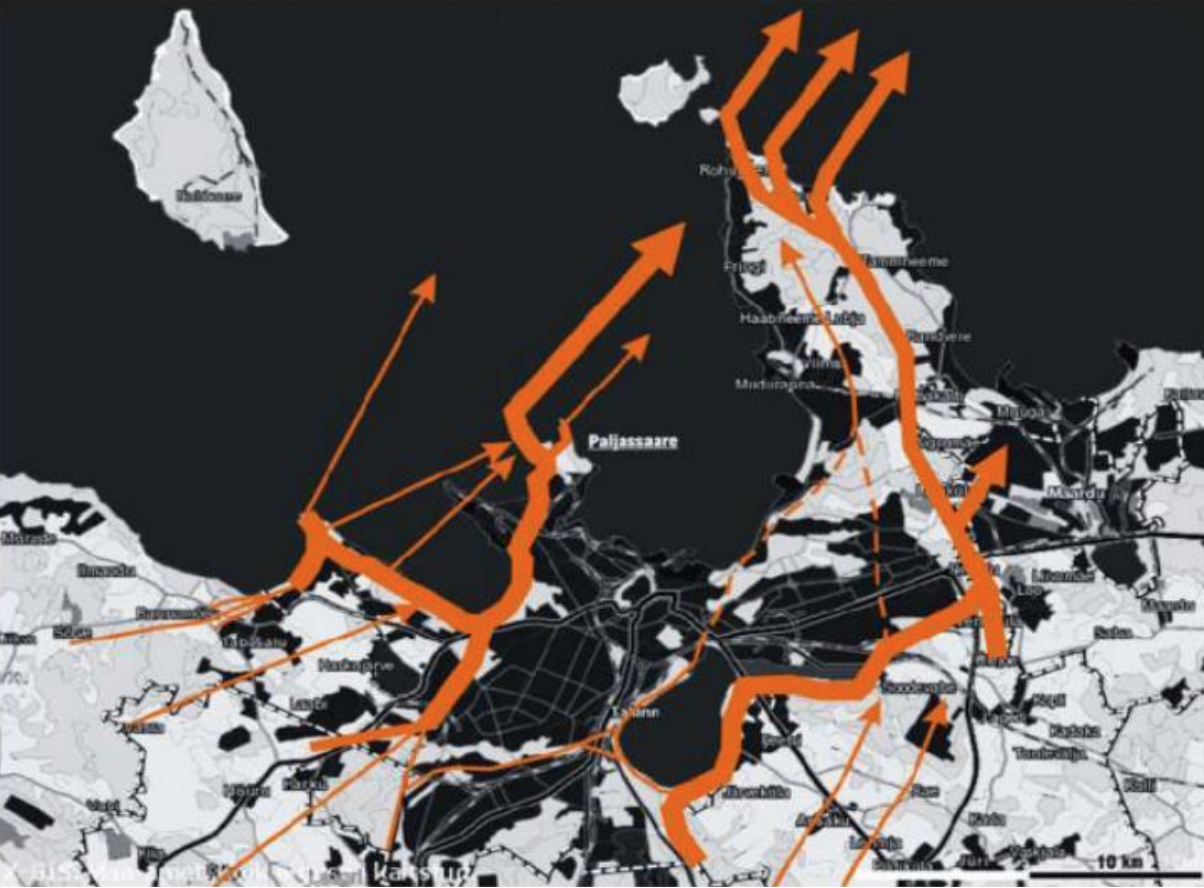Ecobay Swan Song
by Katrin Tomiste
Once an ugly duckling, identified as a brownfield on the west coast of Paljassaare, it has grown into a swan, difficult to turn your eyes off. Ecobay's story began in 2006 when Tallinna Vesi sold this so-called brownfield (48 ha) to a wealthy businessman. Businessman together with developers had great plans and expectations with the site. The plan was to create a sustainable Ecobay city that would set new standards for future ecological urban development, clustering the buildings together in concentrated neighbourhoods, leaving large areas for nature. The detailed Ecobay master plan contained large amounts of different types of smaller and bigger buildings, many of them sixto nine-storey height, that would accommodate around 6000 people.
But the planned eco city Ecobay borders partially the bird's nesting areas, which accommodates many endangered species, including both flora and fauna. The siteIt is protected in the framework of Natura 2000: a network of nature protection areas in the territory of the European Union. Natura 2000 is the largest coordinated network of protected areas in the world, extending across all 28 EU countries, both on land and at sea. That raises the question - has the Ecobay area ever been really a brownfield? In the case of Paljassaare nature protection area and also Ecobay area, all together 233 bird species nest or live here: 5 bird species go under first protection category, 26 have been identified as second category and 53 third category. The area is being used also as a flight corridor among migrating birds.
Nature and endangered birds are clearly at stake with the Ecobay development, it doesn‘t matter how ‘‘green‘‘ they say their future is. The developers of Ecobay experience a cultural shift from an ad hoc to more comprehensive urban planning since agreements made 15 years ago may not be valid anymore and justified expectations can be easily disproved. Another important aspect to bear in mind is that the public use of the Estonian natural environment is based on everyman’s right which allows the general public to access natural and cultural landscapes, regardless of who owns the land. Everyman’s right balances the constitutional freedom of movement with the obligation to avoid causing an environmental nuisance and not harm the interests or property of the owner. But clearly expressing their will, owners can prohibit people from crossing on their land. In the interests of balanced social development, therefore, interaction between private owners, nature visitors and the public authorities should be analysed every time in more detail.
Strategic environmental impact assessment of the general plan of the Northern Tallinn district and Protection plan for the Paljassaare conservation area both indicate: ‘‘It is recommended to repurchase the entire Ecobay property to the state and include it in the Paljassaare Natura area. This would also form an important buffer and compensation area for other North Tallinn development plans."
Site specific rite ‘‘Ecobay swansong‘‘ on the West coast of Paljassaare
This project placed nature as a public environment at stake of urban expansion and invited everybody to recontextualise the site accommodating endangered birds, flora and fauna.
The act consisted of Ecobay detail plan stone skimming, to see how many times an extract from an Ecobay detail plan bounces off the surface of a water before sinking.
Ecobay's sublime Master Plan farewell took place on the West coast of Paljassaare on December19, 2021. And it will not be missed..
An extract from Ecobay detail plan:
- 59 2-storey & 56 3-storey detached houses
- 15 2-storey & 12 3-storey townhouses
- 8 2-storey & 19 3-storey 2-apartment residential buildings
- 14 3-storey & 14 4-storey apartment buildings
- 25 6-storey apartment buildings
- 8 7-9-storey apartment buildings
- 10 commercial buildings of different sizes
- 1 public building
- 3 kindergartens
- a beach promenade
- golf courses
References
Strategic environmental impact assessment of the general plan of the Northern Tallinn district (2012-2021), pp.127-149.
Protection plan for the Paljassaare conservation area 2020 - 2029.
Longing for a greener present (Neoliberalism and the eco-city) by Ross Adams.
Estonian Human Development report 2019/2020 (Natural environment as a public good section).
Äripäev ‘‘Paljassaare megaprojektid: Linnamäe kaotas kohtus, Hääl liigutab miljoneid, aga kalapulgad rikuvad ikka kõik ära.‘‘ (4.12.2020)
But the planned eco city Ecobay borders partially the bird's nesting areas, which accommodates many endangered species, including both flora and fauna. The siteIt is protected in the framework of Natura 2000: a network of nature protection areas in the territory of the European Union. Natura 2000 is the largest coordinated network of protected areas in the world, extending across all 28 EU countries, both on land and at sea. That raises the question - has the Ecobay area ever been really a brownfield? In the case of Paljassaare nature protection area and also Ecobay area, all together 233 bird species nest or live here: 5 bird species go under first protection category, 26 have been identified as second category and 53 third category. The area is being used also as a flight corridor among migrating birds.
Nature and endangered birds are clearly at stake with the Ecobay development, it doesn‘t matter how ‘‘green‘‘ they say their future is. The developers of Ecobay experience a cultural shift from an ad hoc to more comprehensive urban planning since agreements made 15 years ago may not be valid anymore and justified expectations can be easily disproved. Another important aspect to bear in mind is that the public use of the Estonian natural environment is based on everyman’s right which allows the general public to access natural and cultural landscapes, regardless of who owns the land. Everyman’s right balances the constitutional freedom of movement with the obligation to avoid causing an environmental nuisance and not harm the interests or property of the owner. But clearly expressing their will, owners can prohibit people from crossing on their land. In the interests of balanced social development, therefore, interaction between private owners, nature visitors and the public authorities should be analysed every time in more detail.
Strategic environmental impact assessment of the general plan of the Northern Tallinn district and Protection plan for the Paljassaare conservation area both indicate: ‘‘It is recommended to repurchase the entire Ecobay property to the state and include it in the Paljassaare Natura area. This would also form an important buffer and compensation area for other North Tallinn development plans."
Site specific rite ‘‘Ecobay swansong‘‘ on the West coast of Paljassaare
This project placed nature as a public environment at stake of urban expansion and invited everybody to recontextualise the site accommodating endangered birds, flora and fauna.
The act consisted of Ecobay detail plan stone skimming, to see how many times an extract from an Ecobay detail plan bounces off the surface of a water before sinking.
Ecobay's sublime Master Plan farewell took place on the West coast of Paljassaare on December19, 2021. And it will not be missed..
An extract from Ecobay detail plan:
- 59 2-storey & 56 3-storey detached houses
- 15 2-storey & 12 3-storey townhouses
- 8 2-storey & 19 3-storey 2-apartment residential buildings
- 14 3-storey & 14 4-storey apartment buildings
- 25 6-storey apartment buildings
- 8 7-9-storey apartment buildings
- 10 commercial buildings of different sizes
- 1 public building
- 3 kindergartens
- a beach promenade
- golf courses
References
Strategic environmental impact assessment of the general plan of the Northern Tallinn district (2012-2021), pp.127-149.
Protection plan for the Paljassaare conservation area 2020 - 2029.
Longing for a greener present (Neoliberalism and the eco-city) by Ross Adams.
Estonian Human Development report 2019/2020 (Natural environment as a public good section).
Äripäev ‘‘Paljassaare megaprojektid: Linnamäe kaotas kohtus, Hääl liigutab miljoneid, aga kalapulgad rikuvad ikka kõik ära.‘‘ (4.12.2020)













